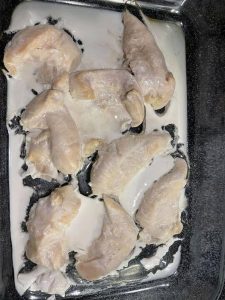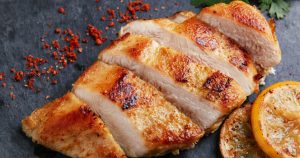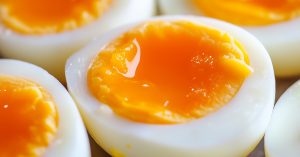If you’ve ever fried a chicken breast and found a strange white, jelly-like substance coming out while it was cooking or after it was done, you’re not alone. You aren’t doing anything wrong. This weird “goop” may not seem pleasant, but it’s safe and healthy to eat. In fact, this happens to chicken in kitchens all throughout the world, from home ovens to professional restaurant grills.
You season the chicken just right, bake it till it’s golden, and then take it out, expecting a tasty, juicy feast. Instead, you see this milky-white, semi-solid liquid pooling on the surface or collecting in the pan. A lot of people think it’s fat, pus, or something that went wrong. It’s not one of those. The truth is a lot less gross and a lot more scientific.

The material in concern is a mix of water and denatured protein, predominantly albumin. Albumin is a type of protein that can break down in water. Meat, especially lean meats like chicken breast, naturally contains it. When you cook chicken, especially at high temperatures, the proteins in it start to denature, or change shape. They get smaller and push water out as they do this. They generate that white stuff when the proteins break down and the water is taken out. The goo you see is what happens when the proteins touch the hot surface or get hot enough inside.
Like when you cook egg whites, this process makes the clear liquid turn white and firm. Chicken is pretty much the same, except when it seeps out while frying, it could look strange because it doesn’t happen in a uniform way like an egg in a skillet.
This is more likely to happen with chicken breast since it is so lean. It has a lot of protein and not a lot of fat. When you microwave boneless, skinless chicken breasts, they lose water quickly since they don’t have skin or bone to hold the moisture in. When you raise the cooking temperature, the proteins squeeze out moisture faster, which makes the white goop more visible.
Some types of cooking can make the goo more visible. Roasting, baking, grilling, and pan-searing all employ direct or high heat, which makes it more likely that this protein will be released. If you cook chicken that is still frozen or only partially thawed, the problem grows worse. The problem is that freezing makes ice crystals form inside the muscle fibers. These crystals damage the cells and break them. The broken fibers can’t hold as much moisture when you thaw and cook the meat, so more of it departs, taking protein with it.

Even though this white material doesn’t look very good, it’s safe to eat. It doesn’t mean that the chicken is poor or not cooked sufficiently. It also doesn’t impact the taste or feel of the meat in a substantial way. If your raw chicken smells bad, feels sticky or slimy, or has a yellowish or greenish color before you cook it, though, it’s a sign that it’s gone bad and you should throw it away. The white goop by itself isn’t a big deal.
If you want to get rid of or decrease this residue for presentation or textural reasons, there are a few good techniques to do so:
Cooking at a lower temperature is better because high heat causes proteins compress quicker and let out more moisture. Instead of 400°F (205°C), try roasting at 350°F (175°C) for a softer cook.
Brine your chicken: Soaking the chicken in a saltwater solution for 30 minutes to an hour helps it stay moist and lose less protein while it cooks. It also makes the dish taste nicer and more juicy.
First, sear the chicken in a hot skillet to maintain the moisture on the outside and stop as much protein from leaking out when it goes in the oven.
Wait a bit before frying it. If you cook cold chicken straight from the fridge (or worse, half-thawed), the chances of this happening go up. Letting your chicken remain at room temperature for 15 to 20 minutes before cooking can help the heat spread out more evenly and make the protein contract less strongly.

Get great chicken: When chicken is raised in a factory or mass-produced, it is typically injected with water or processed in ways that leave too much moisture in the meat. This makes the white filth more noticeable. Organic, free-range, or air-chilled chicken usually has less added water, which means it leaves less residue that you can see.
Don’t put more than one piece of chicken in the pan at a time. The chicken is more likely to steam than sear when you do this. These steps can make more moisture appear, which means that more of the white goo will form.
After cooking, let the chicken sit for a time. This inhibits protein-rich liquids from leaking out during cooking and helps the juices inside the meat spread out.
It’s important to realize that this reaction doesn’t only happen with chicken. You can also get similar results with other lean meats, such turkey or pork, especially if you cook them fast at high temperatures. Chicken is simpler to observe because it is light in color and is generally cut into simple, skinless pieces.
At the end of the day, the white stuff isn’t bad for you, dirty, or a sign that you did something wrong in the kitchen. It’s merely science doing what it does best: figuring out how proteins and heat will interact.
Don’t throw away the chicken or worry that something is wrong the next time you see that strange white goo. Serve it up, enjoy your meal, and relax knowing that the chicken is safe, well-cooked, and delectable.
